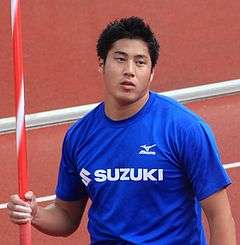Ryohei Arai (athlete)
Ryōhei Arai (新井涼平, Ryōhei Arai, born 23 June 1991) is a Japanese athlete specialising in the javelin throw.[3] He represented his country at the 2015 World Championships finishing ninth. In addition, he won the silver at the 2014 Asian Games.
 Arai at 2016 Bislett Games | ||||||||||||||||||||
| Personal information | ||||||||||||||||||||
|---|---|---|---|---|---|---|---|---|---|---|---|---|---|---|---|---|---|---|---|---|
| Born | 23 June 1991 Saitama Prefecture | |||||||||||||||||||
| Education | Kokushikan University[1] | |||||||||||||||||||
| Height | 1.83 m (6 ft 0 in)[2] | |||||||||||||||||||
| Weight | 90 kg (200 lb) | |||||||||||||||||||
| Sport | ||||||||||||||||||||
| Sport | Track and field | |||||||||||||||||||
| Event(s) | Javelin throw | |||||||||||||||||||
| Club | Suzuki Hamatsu AC | |||||||||||||||||||
| Coached by | Yoshinari Kuriyama | |||||||||||||||||||
Medal record
| ||||||||||||||||||||
His personal best in the event is 86.83 metres set in Isahaya in 2014.
Competition record
| Year | Competition | Venue | Position | Event | Notes |
|---|---|---|---|---|---|
| Representing | |||||
| 2013 | Universiade | Kazan, Russia | 8th | Javelin throw | 75.53 m |
| 2014 | Asian Games | Incheon, South Korea | 2nd | Javelin throw | 84.42 m |
| 2015 | World Championships | Beijing, China | 9th | Javelin throw | 83.07 m |
| 2016 | Olympic Games | Rio de Janeiro, Brazil | 11th | Javelin throw | 79.47 m |
| 2017 | World Championships | London, United Kingdom | 23rd (q) | Javelin throw | 77.38 m |
| 2018 | Asian Games | Jakarta, Indonesia | 7th | Javelin throw | 75.24 m |
| 2019 | Asian Championships | Doha, Qatar | 3rd | Javelin throw | 81.93 m |
| World Championships | Doha, Qatar | 15th (q) | Javelin throw | 81.71 m | |
Seasonal bests by year
- 2011 – 78.21
- 2012 – 78.00
- 2013 – 78.19
- 2014 – 86.83
- 2015 – 84.66
- 2016 – 84.54
- 2017 – 82.13
- 2018 – 80.83
- 2019 – 82.03
gollark: No, the y intercept is the value when x = 0.
gollark: Why?
gollark: What would?
gollark: So you have 3 as the gradient (m), so your equation is y = mx + c, but you don't know what c is.
gollark: (10-4)/(3-1)?
References
- 2013 WSG profile
- 2014 AG profile Archived 2014-10-07 at the Wayback Machine
- Ryohei Arai at World Athletics
This article is issued from Wikipedia. The text is licensed under Creative Commons - Attribution - Sharealike. Additional terms may apply for the media files.